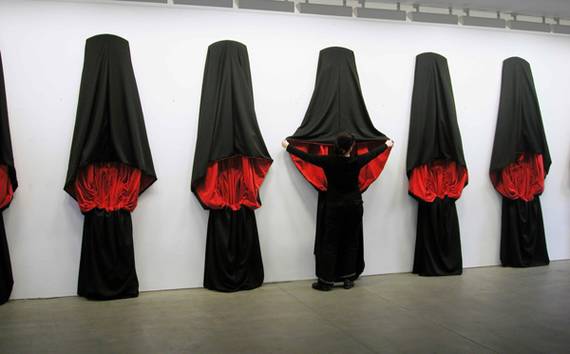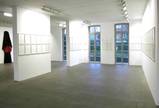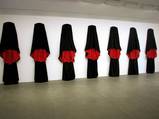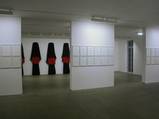Exhibitions 2006
Ursula Neugebauer
 |
Von der Verhüllung der Erotik zur Erotik der Verhüllung
From the disguise of eroticism to the eroticism of disguise
10 December to 18 February 2007
Nothing new in the West? No way! Since September 11, 2001, Muslims are under general suspicion. Islamic women, who seal themselves off from the public eye with their veiled clothing, are perceived as threatening and experience aggressive rejection. Chador and headscarf are generally regarded as patriarchal oppression of women by men and religion. But one-dimensional explanatory patterns with a claim to absoluteness fade out nuances and are therefore wrong.
In new works, the artist Ursula Neugebauer, who lives in Berlin and teaches at the UdK in Berlin, has dealt with the spheres of the private and the public in the context of religious determination. They were recently presented in the ambitiously managed Kunstverein in Grafschaft Bentheim in Neuenhaus, managed by Gudrun Thiessen-Schneider. Ursula Neugebauer has already devoted herself to the turmoil of psyche and body and found poetic images for it. Crossing boundaries, alienation, hysteria and the turning over in action are already alluded to in the titles. "Aus der Haut gefahren" is the name of an earlier installation, which was presented as a new photographic work in Neuenhaus. The artist's clothes seem to have a life of their own, as they are constantly moved by motorized balls attached to them. The diptych symmetrically juxtaposes two almost identical scenes, whereby the movement is more visible in the right-hand picture. The driving out of the second skin, the peeling off and being naked is a game about love, sexuality, intimacy and personality. This work is based on a Western understanding and relationship to body, sexuality and the public, because in modern Western society the boundaries for intimacy dissolve and sexuality and psyche are treated publicly and often turned outwardly in a degrading way, often to the point of intolerability. A new puritanism of a fundamentalist kind is emerging against shamelessness, and this is not only to be found in the USA.
Ursula Neugebauer's new works take a contrasting line of vision by focusing on the act of concealment. With a nun and a young Muslim woman, the artist has conducted conversations about their understanding of beauty, hair, body and intimacy and has processed them into a remarkable DVD projection. The 64-year-old sister of the order "Unserer Lieben Frau" from Berlin, who is active in marriage, family and life counselling (!), comments on her relationship to hair, body and veiling just as much as the very eloquent 25-year-old German-born political science student from a Turkish family. Both confidently represent their lives in accordance with their respective religion. Interestingly, the Muslim woman comes from a secular family and as a teenager she was more religiously oriented and made a conscious decision to cover her hair. She uses this turning to religion as a means of creating identity in a society that is perceived as hostile. This leads to a strong orientation towards the values represented with a claim to exclusivity, which implicitly implies a rejection of other values. One's own ideal of beauty is hermetically linked to one's own ethnic group, so that only black hair is perceived as erotic. The fact that both representatives were willing to engage in this experiment at all is a strength that makes them sympathetic and makes a rejecting position more difficult.
For a cycle of paintings, Ursula Neugebauer asked women to give her hair to create the "hair drawings". The donor's hair is fixed in the shape of her body profile on a 43x32 cm sheet. 100 of these fragile-looking portraits of women were shown in Neuenhaus. In each case 50 portraits are made with hair of Muslim women from Berlin and 50 with hair of non-Muslim women from Neuenhaus, which could be won for hair donation. Their portraits are strongly influenced by the fashion of dyeing and tinting, while the pictures of the Muslim women are all made of black hair.
The Muslim women have thus just "sacrificed" the symbol of intimacy, one of their "body treasures", which is only revealed to the man and the closest family, as material for the figurative representation of their bodies for the public. Even if the donors remain anonymous, it would be interesting to find out whether they have thereby violated a sacrilege. In the back room, seven chadors sewn by the artist were attached to the wall in a row as textile sculptures. The openings gape apart and reveal a bright red lining. In this way, the artist consciously intends the association with body, sexuality, passion and vulva. There is a direct relationship between veiling and eroticism. Islam knows - just like Christianity - about the power of eroticism and the fascination of the female body on men and therefore demands veiling, which in turn gives free rein to the imagination. Homosexual relationships do not exist at all on this level, but they are also not mentioned in the Old and New Testament stories. One must be warned against Western arrogance in judgement, because isn't it possible that women also see the chador as protection against intrusive looks? And further asked: Is the loss of shame in many mediatized western societies a liberation? One should also recall the development of German post-war society from bourgeois prudery to the loss of shame within only 50 years in the mind.
The installation of the chadors also has a violent connotation and is reminiscent of eviscerated animals hanging in a slaughterhouse. With this ambivalence, Ursula Neugebauer creates images that allow us to reflect on our relationship to the body and sexuality in contrast to Islamic societies.
Matthias Reichelt
in: Kunstforum International, Vol. 184, March - April 2007
Catalogue "Ursula Neugebauer, driven out of her skin", 90 pages in colour, with texts by Manfred Schneckenburger, Michael Stoeber, Ferdinand Ullrich and others.









